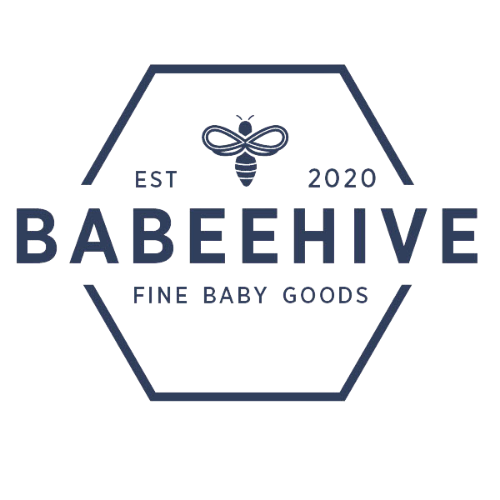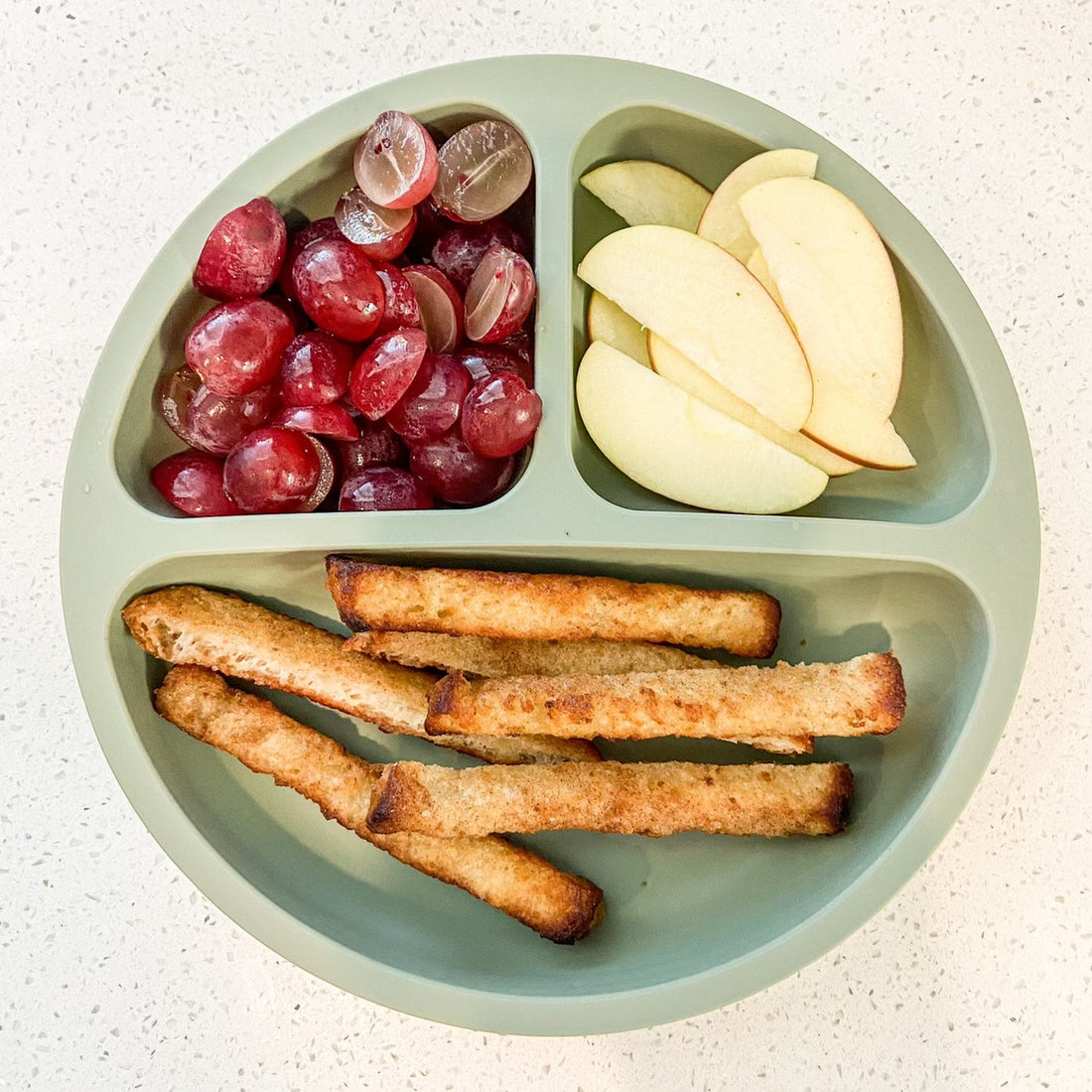Your newborn is starting to grow, and lots of exciting changes are happening. They’re awake for more extended periods of time, their eyes are beginning to focus on nearby objects and faces, and their facial expressions are starting to make more frequent appearances.
You’ll also find yourself introducing solid foods to your baby soon. This is a huge step, both for you as a parent and for your little one. It’s exhilarating, and also extremely intimidating.
Knowing where to start, what to introduce first, how to prepare their first solids and understanding when it’s time to transition to other foods is a lot to keep track of.
We have everything you need to know about introducing solid foods to your baby, when to do it and how to do it. Let’s jump in!

Four Months: The First Solid Foods
There are a few signs to look out for that tell you when your baby is ready for his or her first solids. According to KidsHealth, “To eat, babies need good head and neck control and should be able to sit up in a high chair. This usually doesn’t happen until they’re 4 to 6 months old.”
Some other signs include:
- Their tongue-thrusting reflex is going away. If you try spoon-feeding your baby when they still have this reflex, they will push the food out of their mouth.
- They weigh twice their birth weight.
- They’re showing more interest in food in general: watching you eat, reaching out for food and opening their mouth when food comes close.
If your baby starts showing some of these signs, it’s time to give solid foods a shot!
Foods to Introduce
Start simple. Pureed foods that only have one ingredient are going to be best. While you don’t necessarily have to, we recommend starting with soft foods. Give your baby one kind of food for four to seven days. That way, if they’re allergic to something, you won’t be guessing which food it was of the various options you gave them.
Some great foods to start with include:
- Sweet potatoes
- Squash
- Bananas
- Apples
- Mangos
- Peaches
- Pears
- Avocados

Supplies You Need
So what exactly do you need for your baby’s first meal? For starters, you’ll need a high chair. You’ll also need a spoon and bib. We highly recommend silicone baby bibs. They’re incredibly easy to clean and have a handy little pocket to catch the food that will inevitably drip out of your little one’s mouth. This way their outfit will come out unscathed.
You might also consider getting a subo bottle for your baby. Designed to encourage independence during mealtime, you can put in anything from purees to applesauce to rice cereals and more. What’s even better? Subo bottles are made to be reused time and time again, so this mess-free option is also environmentally friendly.
How To Do It
Get your baby settled in their high chair and fasten a bib around their neck. Starting with a very small amount of pureed food on the spoon, offer the food to your baby. It may take a few tries for them to open their mouth, and even after that, it may take a few more tries for them to swallow the food. Be patient and keep trying, slowly increasing the amount of food you offer on the spoon.
If you try and your baby simply isn’t interested, don’t stress too much. Especially if you’re starting at the 4-month mark, their tongue thrusting reflex may not be fully developed yet, or perhaps they’re just not ready to take this step. Give it another week or so and try again. Soon enough, they will catch on.
Baby-Led Weaning
Another option you might consider for your little one is baby-led weaning. This is where you let your baby feed themselves, starting as early as 6 months old. Baby-led weaning has been proven to help with things like fine motor development and developing chewing skills. It can be a wonderful mealtime option either on its own or paired with pureed spoon-feeding.
When considering which foods to introduce for baby-led weaning, it’s really all about how it’s being prepared. Whatever food you give your baby, make sure it’s cut into long strips that they can easily grasp. You’ll also want to be mindful when cooking certain foods so that they are soft and easily eaten. For example:
- Roast sweet potatoes
- Roast apples
- Roast broccoli
- Whole banana with some of the peel still on
- Sliced avocado
- Sliced melon
- Sliced cucumber
When properly cut and cooked, you’re setting your little one up for successful baby-led weaning.

Eight Months: Introducing Table Foods
Right around 8 or 9 months, it will be time to start introducing table foods to your baby. This is another big and exciting step for them! You’ll know your baby is ready for table foods if you start seeing these signs:
- They’re sitting up on their own, both during playtime and in their high chair
- They can bring food to their mouth on their own
- They’re showing less interest in pureed foods
Foods to Introduce
Think soft fruits and vegetables. Some of our favorites include:
- Blueberries
- Bananas
- Avocado
- Sweet Potato
- Peas
- Carrots
- Squash
As with selecting food for baby-led weaning, you will want to be mindful of how you’re preparing table food for your baby. Cut up the food into pieces that are small enough for them to fit into their mouth and easily chew.
You’ll also want to make sure that everything is soft enough for your baby to eat. You don’t have to wait for your baby’s teeth to come in to introduce table food; however, this does mean that foods need to be properly prepared to prevent choking. Boiling or roasting hard fruits and vegetables is a great way to go.
Supplies You’ll Need
In addition to a high chair and bib, you will want the proper feeding supplies for your baby when introducing table food. Toddler plates and toddler bowls that suction to the high chair tray and table are going to be a huge lifesaver! Let your little one practice their independence without them throwing everything on the floor in one fell swoop.
How to Do It
Put your baby in their high chair and suction the plate or bowl with the prepared food on the tray. Sit near them as they experiment with the food. If they’re struggling to get it in their mouth, put a few pieces in their mouth to get them going, and then practice guiding their hands to their mouth. With time, they will get it down; they’re bound to love mealtime!
Dysphagia
Dysphagia is the medical term for someone with swallowing issues. It could be difficult to swallow liquids or solids, and it ranges from partial to complete blockage. If you have a baby that is struggling with dysphagia, finding mealtime solutions can be incredibly difficult.
Our son was struggling with dysphagia (you can read our dysphagia story here) and we needed something that would help him get the nutrients he needed. The product that changed everything for us was the Subo bottle because it’s designed for children with low muscle tone and swallowing problems. Check out our dysphagia resources for support.
All of these transitions with feeding your baby don't have to feel overwhelming; make sure you have a plan and the right supplies, and you’re sure to see success!

